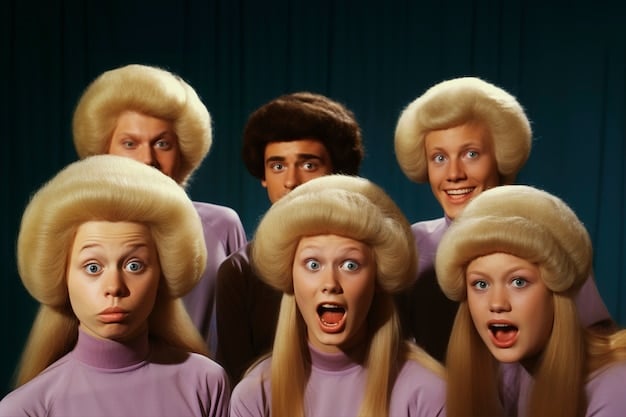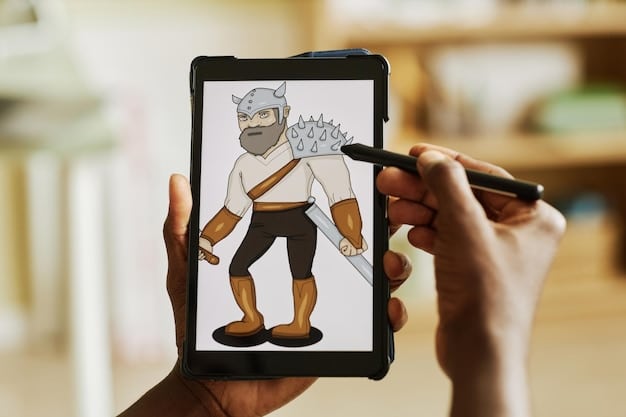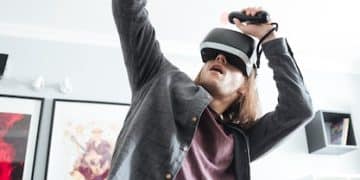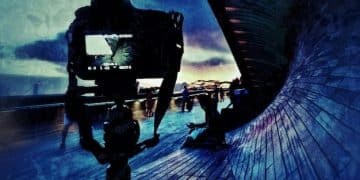Behind the Scenes: Unveiling US Movie Animation Technology Advancements

Exclusive: Behind-the-scenes look at the latest advancements in US movie animation technology reveals cutting-edge techniques, software innovations, and the creative processes shaping modern cinematic experiences, offering a glimpse into the future of animated films in the United States.
Get ready for an exclusive look at the incredible advancements happening behind the scenes in US movie animation! From groundbreaking software to innovative techniques, the world of animated filmmaking is constantly evolving. Join us as we take you on a journey to explore the latest and greatest in exclusive: behind-the-scenes look at the latest advancements in US movie animation technology.
The Evolution of US Movie Animation
The animation industry in the United States has undergone a dramatic transformation over the decades. From traditional hand-drawn techniques to sophisticated computer-generated imagery (CGI), the evolution has been driven by technological innovation and artistic vision. Let’s delve into the key milestones that have shaped the animation landscape we know today.
Early Innovations in Animation
The journey began with pioneers experimenting with basic animation principles, such as stop-motion and cel animation. These early techniques laid the groundwork for the more advanced methods that would follow.
One of the most significant shifts occurred with the introduction of computer animation. This revolutionized the industry, allowing for unprecedented levels of detail and realism.

The Rise of CGI and 3D Animation
CGI animation emerged as a dominant force, enabling filmmakers to create visually stunning worlds and characters. The development of 3D animation further enhanced the immersive experience for audiences.
- Advancements in rendering software have significantly improved the speed and quality of CGI.
- Motion capture technology allows animators to create more realistic character movements.
- The integration of artificial intelligence is streamlining various aspects of the animation process.
In conclusion, the evolution of US movie animation is a testament to the relentless pursuit of innovation and the power of creative storytelling. From humble beginnings to cutting-edge technology, the industry continues to push the boundaries of what is possible.
Key Software Innovations Driving Animation
Software plays a pivotal role in modern animation, providing artists with powerful tools to bring their visions to life. Here are some of the key software innovations that are shaping the future of US movie animation.
Industry-Leading Animation Software
Several software packages have become staples in the animation industry, offering a wide range of features and capabilities. These tools empower animators to create complex characters, environments, and visual effects.
Among the most popular options are Autodesk Maya, Adobe Animate, and Blender. Each offers unique strengths, catering to different styles and workflows.
AI-Powered Animation Tools
Artificial intelligence is increasingly being integrated into animation software. AI-powered tools can automate repetitive tasks, enhance realism, and accelerate the animation process.
- AI algorithms can assist with tasks such as motion capture cleanup and facial animation.
- Machine learning models can predict and generate realistic character movements.
- AI-driven tools can optimize rendering processes, reducing production time and costs.
In summary, software innovations are transforming the animation industry, providing artists with powerful tools to create visually stunning and emotionally engaging films. The integration of AI is poised to further revolutionize the field, unlocking new possibilities for creative expression.
The Art of Motion Capture in Animation
Motion capture technology has become an indispensable tool in modern animation, allowing animators to create realistic and nuanced character movements. Here’s a closer look at how motion capture is used in US movie animation.
How Motion Capture Works
Motion capture involves recording the movements of real-world actors and translating that data into digital characters. This technique allows animators to capture the subtleties of human performance, adding a layer of realism to their creations.
The process typically involves actors wearing specialized suits equipped with sensors. These sensors track the actors’ movements, which are then mapped onto digital models.
Benefits of Motion Capture
Motion capture offers several benefits over traditional animation techniques. It can significantly reduce production time, enhance realism, and allow for more complex character interactions.

- Motion capture allows animators to capture realistic facial expressions and body language.
- It can be used to create more dynamic and engaging action sequences.
- Motion capture data can be easily refined and adjusted, providing animators with greater control over the final product.
In conclusion, motion capture is a powerful tool that is transforming the way animated characters are brought to life. By capturing the nuances of human performance, it allows animators to create more believable and engaging stories.
Virtual Production and Real-Time Rendering
Virtual production and real-time rendering are revolutionizing the way animated films are made in the US. These technologies allow filmmakers to create and visualize scenes in real-time, blurring the lines between pre-production and post-production.
What is Virtual Production?
Virtual production involves using real-time rendering engines and virtual sets to create a more immersive and interactive filmmaking experience. This allows directors and animators to make decisions on the fly, rather than waiting for post-production.
Virtual production can significantly reduce production time and costs, while also allowing for greater creative flexibility.
The Role of Real-Time Rendering
Real-time rendering is a key component of virtual production. It allows animators to see their creations in near-final quality, providing immediate feedback and enabling faster iteration.
This technology is particularly useful for creating complex visual effects and environments.
Virtual production techniques facilitate collaborative workflows, allowing artists from different disciplines to work together more effectively.
Real-time rendering engines enable filmmakers to experiment with different lighting and camera angles, enhancing the visual storytelling process.
Virtual sets allow directors to visualize the film’s environment in detail, improving pre-production planning and decision-making.
In summary, virtual production and real-time rendering are transforming the landscape of US movie animation, offering filmmakers powerful tools to create more immersive and visually stunning films.
The Impact of Cloud Computing on Animation Workflows
Cloud computing has emerged as a game-changer for animation workflows, providing studios with scalable resources and collaborative tools. Here’s how cloud technology is impacting the US movie animation industry.
Benefits of Cloud-Based Animation
Cloud computing offers several advantages for animation studios, including increased flexibility, scalability, and cost-effectiveness. It allows artists to access their work from anywhere in the world, facilitating remote collaboration and streamlining workflows.
Studios can scale their computing resources on demand, avoiding the need to invest in expensive hardware infrastructure.
Collaborative Workflows in the Cloud
Cloud-based platforms enable artists to collaborate more effectively, sharing assets and feedback in real-time. This can significantly reduce production time and improve the overall quality of the animation.
- Cloud storage solutions provide secure and centralized access to animation assets.
- Version control systems ensure that artists are always working with the latest versions of their files.
- Cloud-based rendering farms accelerate the rendering process, allowing studios to deliver projects on time and on budget.
In conclusion, cloud computing is revolutionizing animation workflows, providing studios with the tools and resources they need to create high-quality animated films more efficiently and cost-effectively.
The Future of US Movie Animation Technology
The future of US movie animation technology is bright, with ongoing advancements promising to further revolutionize the industry. From AI-driven tools to immersive virtual experiences, the possibilities are endless. Let’s explore some of the key trends shaping the future of animation.
Emerging Technologies to Watch
Several emerging technologies are poised to transform the animation landscape, including artificial intelligence, virtual reality, and augmented reality. These technologies offer exciting new opportunities for storytelling and audience engagement.
AI-powered tools will continue to automate repetitive tasks and enhance the realism of animated characters.
Immersive Animation Experiences
Virtual reality (VR) and augmented reality (AR) are opening up new possibilities for immersive animation experiences. These technologies allow audiences to step inside the world of their favorite animated films, creating a more engaging and interactive experience.
- VR animation experiences can transport viewers to fantastical worlds and allow them to interact with characters in real-time.
- AR animation can overlay animated characters and effects onto the real world, creating unique and interactive experiences.
In summary, the future of US movie animation technology is filled with exciting possibilities. As technology continues to evolve, we can expect to see even more innovative and immersive animated films in the years to come.
| Key Aspect | Brief Description |
|---|---|
| 🎬 Animation Software | Tools like Maya and Blender drive animation quality. |
| 🤖 AI Integration | AI automates processes and enhances realism. |
| ☁️ Cloud Computing | Enables remote collaboration and scalability. |
| 🎭 Motion Capture | Captures realistic actor movements. |
Frequently Asked Questions
▼
Motion capture involves recording the movements of actors and translating that data into digital characters. This adds realism to animated movements and reduces production time.
▼
Cloud computing provides animation studios with scalable resources, facilitates remote collaboration, and reduces the need for expensive hardware, improving efficiency.
▼
Key software innovations include tools like Autodesk Maya, Adobe Animate, and Blender, which offer advanced features for character creation, environment design, and visual effects.
▼
▼
Virtual production uses real-time rendering engines and virtual sets for immersive filmmaking, allowing directors and animators to make immediate decisions, blurring the lines between pre- and post-production.
Conclusion
The US movie animation industry continues to be a hotbed of innovation, driven by relentless technological advancements and creative storytelling. From motion capture to cloud computing and AI integration, these tools are transforming how animated films are made, promising a future filled with even more immersive and visually stunning cinematic experiences.


![Special Effects Secrets: Making [Movie Title] Magic for Under $50K Special Effects Secrets: Making [Movie Title] Magic for Under $50K - Cover Image](https://endingnew.com/wp-content/uploads/2025/06/endingnew.com_13_1749558769_a0223f59_cover-360x180.jpg)


